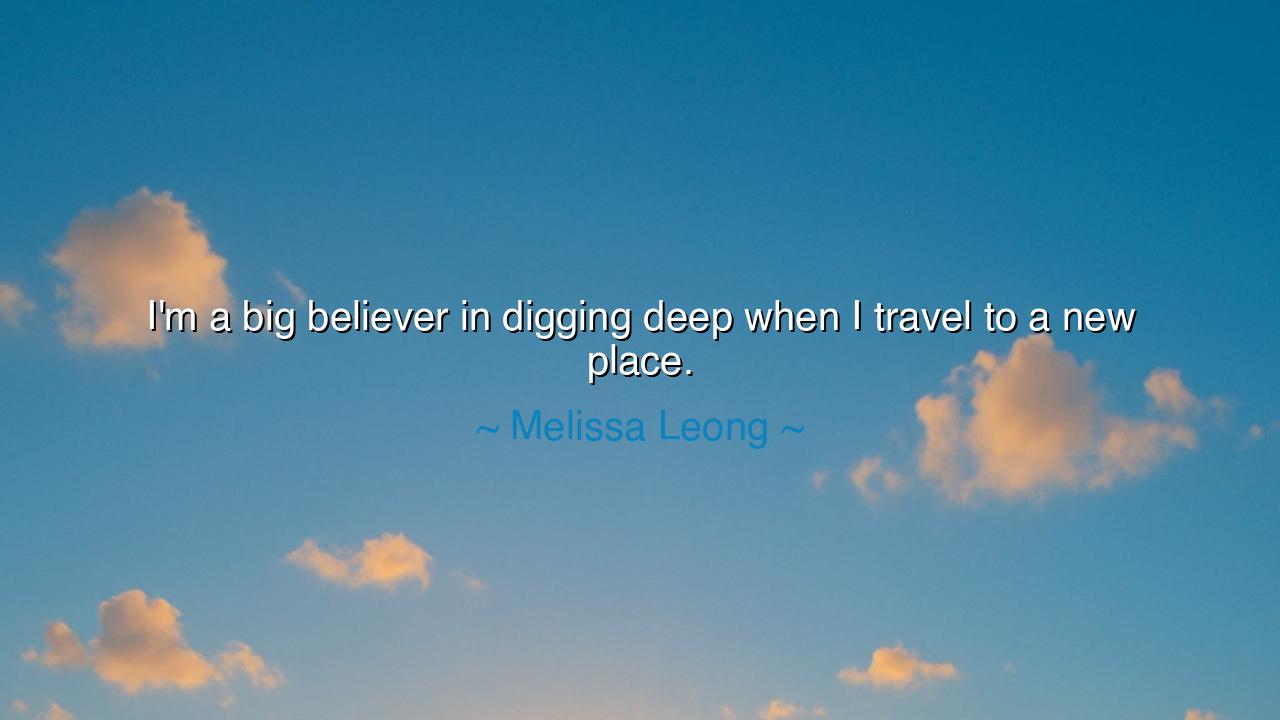
I'm a big believer in digging deep when I travel to a new place.






When Melissa Leong declared, “I’m a big believer in digging deep when I travel to a new place,” she revealed a truth that transcends the casual act of tourism. Her words remind us that the purpose of journeying across the earth is not simply to skim the surface, to collect trinkets, or to boast of destinations visited. It is instead to immerse oneself, to sink roots even in foreign soil, and to drink deeply of the spirit of a land and its people. To dig deep is to encounter not only the sights, but the soul of a place.
The meaning here is profound. Too often, travelers content themselves with the shallow glance—the monuments photographed, the meals tasted, the boxes ticked. But these are but shadows of experience. To travel truly is to listen to the stories of the people, to walk the backstreets and not only the boulevards, to feel the heartbeat of a culture in its music, its struggles, its joys, and its sorrows. The traveler who digs deep does not merely pass through; he allows the place to pass through him, leaving traces upon his soul.
History gives us shining examples of this kind of deep travel. Consider Herodotus, the father of history, who journeyed not to conquer, but to understand. He listened to priests in Egypt, merchants in Babylon, and warriors on the steppes. By digging deep into the lives and customs of those he met, he preserved for all time a tapestry of human diversity. Or think of Richard Burton, the nineteenth-century explorer who disguised himself to enter forbidden Mecca, learning languages and living among peoples as one of them. His journeys were not measured in miles, but in insight.
There is also a personal courage in Leong’s creed. To dig deep demands humility, for one must admit ignorance and become a student again. It demands patience, for truth is not given quickly but revealed slowly to those who listen. It demands vulnerability, for to immerse oneself is to be changed. Shallow travel allows one to remain comfortable and detached; deep travel forces one to reckon with difference and to grow from it.
The lesson is clear: go beyond the surface, in journeys and in life. When you enter a new city, do not rush only to its famous sights—sit in its markets, speak with its elders, watch its children at play. When you eat, taste not only with the tongue but with the imagination, considering the history and hands that brought the dish to life. When you listen, hear not only the words but the silences, the pauses, the unspoken truths. In this way, travel becomes not escape, but transformation.
Practical wisdom flows from this. Before you set foot in a land, learn something of its history and struggles. While you are there, spend time with those who are not tour guides but neighbors, workers, storytellers. Write not only of what you saw, but of what you felt and learned. Carry home not only souvenirs, but insights and humility. For the traveler who digs deep enriches not only himself, but also all who will one day hear his stories.
Thus Melissa Leong’s words shine with ancient resonance: “I’m a big believer in digging deep when I travel to a new place.” They are not only advice for the tourist, but wisdom for the seeker. For life itself is a journey, and in all things—relationships, work, faith, and discovery—the shallow glance is never enough. To live fully is to dig deep, to embrace with courage what lies beneath the surface, and in doing so, to be forever transformed.






AAdministratorAdministrator
Welcome, honored guests. Please leave a comment, we will respond soon